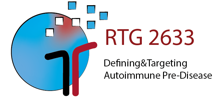Nora Schoell
The influence of prednisolone treatment on split formation in the human skin organ culture model for pemphigus vulgaris
Pemphigus vulgaris (PV) is an organ-specific autoimmune blistering disease of the skin. It is characterized and caused by a pathological formation of circulating autoantibodies against the desmoglein 1 (Dsg1) and/or Dsg3. Binding of anti-Dsg1 and anti-Dsg3-autoantibodies disrupts cell-cell adhesion between keratinocytes, resulting in intraepidermal blistering (acantholysis) in the epidermis and mucous membranes alike (Hammers and Stanley, 2016). On top of the visible clinical symptoms, intraepithelial split formation in histological sections can be observed. Current therapeutic approaches involve high dose, systemic corticosteroids, immunoapheresis of circulating antibodies and intravenous administration of immunoglobulins, including the anti-CD20-antibody Rituximab (Hammers & Stanley, 2016). All these therapeutic options target general immunosuppression. In my project, I will observe the effects of prednisolone treatment in the human skin organ culture model, which was previously established in the hundt lab (Burmester et al., 2019). Two sets of data with a different outcome were achieved in the project-related previous work. The question we would like to answer is whether this difference is due to a different dosage of prednisolone. For this purpose, we will perform new human skin organ cultures for PV. The aim is to clarify if there is a definite effect of prednisolone as a treatment option for PV in the HSOC model.

- People
- Doctoral Candidates
- Merabell Adem
- Katja Adriany
- Farbod Bahreini
- Estelle Bergmann
- Swayanka Biswas
- Jana Buhre
- David De Luca Laredo
- Kaan Ersoy
- Ferdinand Gebauer
- Sen Guo
- Veronika Hartmann
- Michelle Hein
- Luise Janusch
- Maj Jäpel
- Anna Knauer
- Valentin Kneitz
- Maximilian Lahmer
- Wing Yu Lee
- Daniel Mehlberg
- Sahar Mehrabani
- Afsaneh Mehrpouyan
- Sadegh Mousavi
- Milica Novovic
- Justus Ohmes
- Bianca Opelka
- Colin Osterloh
- Cristian Papara
- Tina Rastegar Lari
- Rochi Saurabh
- Alessia Maria Sbaraglia
- Jovan Schanzenbacher
- Mareile Schlotfeldt
- Carolin Schmidt
- Solveig Lea Schmidt
- Leon Schmidt-Jiménez
- Nora Schoell
- Salomini Sinnathurai
- Sarah Stenger
- Chiara Walczyk
- Nele Wellbrock
- Julia Wimmer-Gross
- Natalia Zappe
- Jianrui Zheng
- Luca Zillikens
- Carla Zünkeler
- Principal Investigators
- Associated Scientists
- Administration
- Doctoral Candidates




